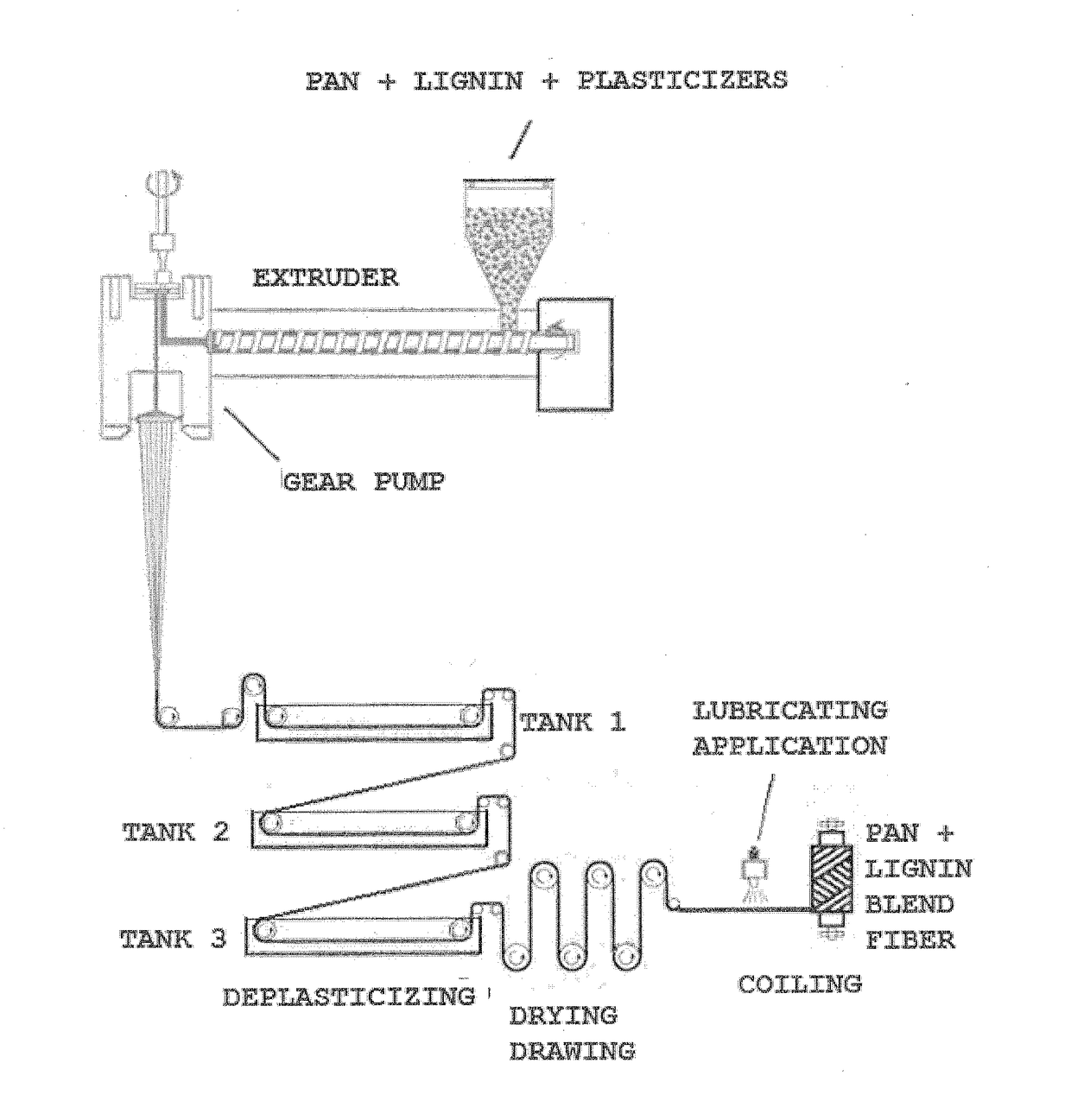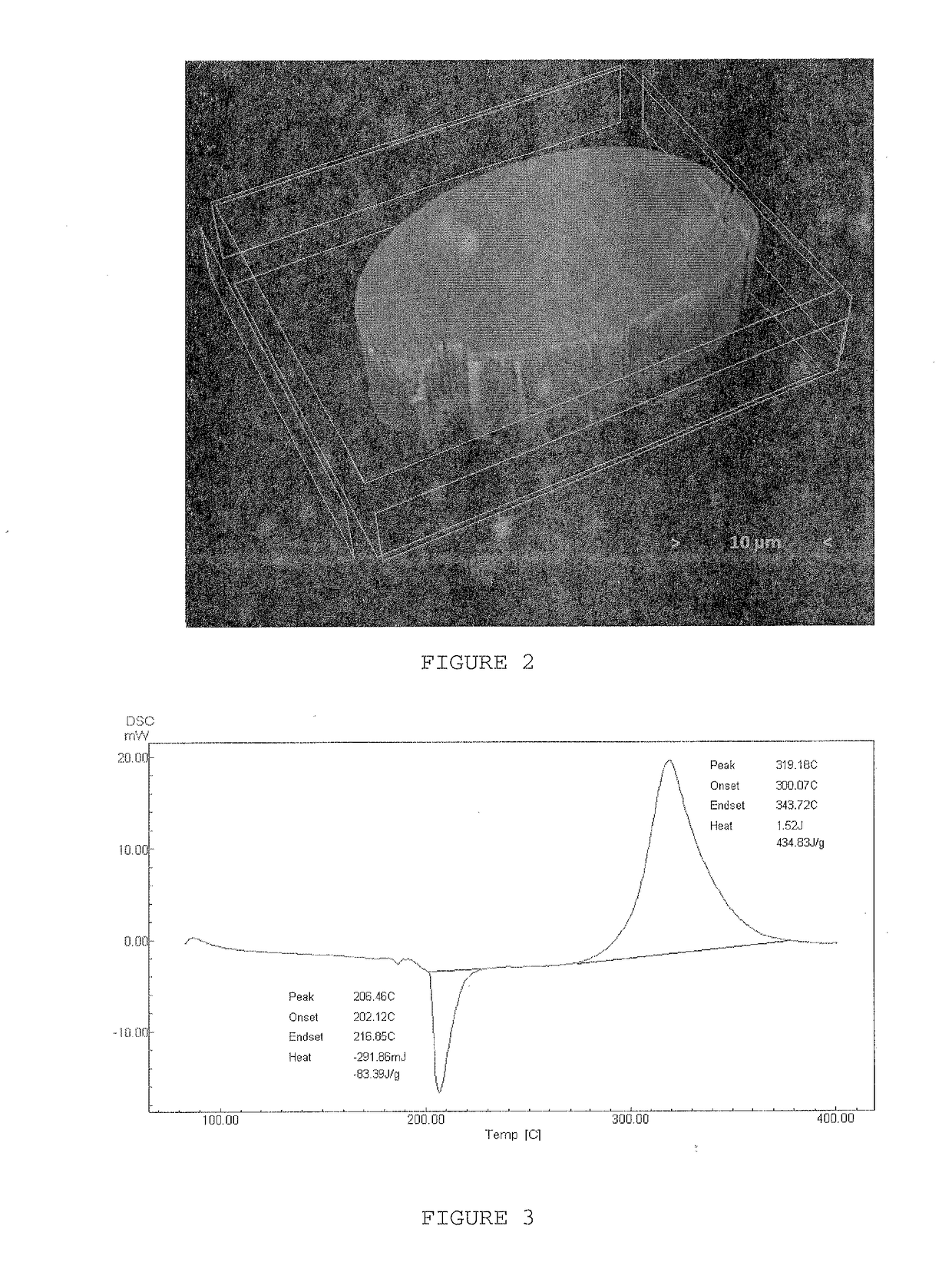Composition of polyacrylonitrile/lignin blend and use thereof in melt spinning carbon fibre precursors
a technology of polyacrylonitrile and lignin, which is applied in the direction of fibre chemical features, conjugated synthetic polymer artificial filaments, synthetic filaments, etc., can solve the problems of unmeltable product, brittleness, dark, etc., and achieve low cost, no toxicity, and high production
- Summary
- Abstract
- Description
- Claims
- Application Information
AI Technical Summary
Benefits of technology
Problems solved by technology
Method used
Image
Examples
example 01
[0049]Approximately 1500 g (54.7%) PAN copolymerized with 6% vinyl acetate with Mw 138,000, moisture content of 0.7% and particle size <20 μm, was blended into a blender at 75° C. (18.2%) of Kraft Lignin, 525.0 g (19.2%) glycerol, 40.0 g (1.5%) 3-chloro-1,2-propanediol, 110.0 g (3.4%) of glyceryl monostearate, 50.0 g (1.8%) of 85% phosphoric acid and 16.0 g (0.6%) of ethylene glycol. After 20 minutes of homogenization the mixture was cooled for 1 hour. The obtained mass was sieved and the passing fraction less than 100 μm was separated and fed into a 20 mm thread extruder at a speed of 60 rpm with 5 heating zones, the first area being 210° C., second, third and fourth Zones being 205° C. and the fifth zone comprising the gear pump and the spinnerette at 210° C. In this example the spinnerette had 90 holes with a diameter of 250 μm. The fiber cable was deplasticized with hot water in three baths with respective temperatures of 70° C., 80° C. and 93° C., dried at a rate of 40 m / min at...
example 02
[0051]approximately 1500 g (51.3%) PAN copolymerized with 6.0% vinyl acetate with Mw 138,000, moisture content of 0.7% and particle size <20 μm, was blended into a blender at 90° C. under stirring with 500 g (17.1%) Kraft Lignin, 586 g (20.0%) glycerin, 147 g (5.0%) glycerol carbonate, 29.0 g (1.0%) of 3-chloro-1,2-propanediol, 70.0 g (2.4%) of glyceryl monooleate, 65.0 g (2.2%) of 85% phosphoric acid and 28.0 g (1.0%) of ethyleneglycol. After 20 minutes of homogenization the mixture was cooled for 1 hour. The obtained mass was sieved and the passing fraction less than 100 μm was separated and fed into a 20 mm thread extruder at a speed of 75 rpm with 5 heating zones, the first area being 205° C., second, third and fourth zone being 210° C. and the fifth zone comprising the gear pump and spinnerette 205° C. In this example the spinnerette had 50 holes with a diameter of 500 μm. The fiber cable was deplasticized with hot water in three baths at respective temperatures of 70° C., 80° ...
example 03
[0053]approximately 1600 g (55.7%) PAN copolymerized with 10% styrene with MW 158,000, moisture content of 0.50% and particle size <20 μm, was blended in a blender at 90° C. under stirring with 400 g (13.9%) of Kraft Lignin, 500 g (17.4%) of glycerin, 150 g (5.2%) of glycerol carbonate, 71.0 g (2.5%) bromo-1,2-propanediol, 35.0 g (1.2%) of PVC NORVIC SP 700 HF' (Braskem), 80.0 g (2.8%) of 85% phosphoric acid and 35.0 g (1.2%) of diethyleneglycol.
[0054]After 20 minutes of homogenization the mixture was cooled for 1 hour. The obtained mass was sieved and the passing fraction less than 100 μm was separated and fed in a 20 mm thread extruder and extruded at a speed of 60 rpm with 4 heating zones, the first zone being 195° C., the second and third being 200° C. and the fourth zone being 200° C. comprising a 3 mm diameter bore head. The extrudate was drawn up to 1.5 mm in diameter and cut into 2 mm long pellets.
[0055]These pellets were fed into a 20 mm thread. extruder and extruded at a s...
PUM
| Property | Measurement | Unit |
|---|---|---|
| boiling point | aaaaa | aaaaa |
| diameters | aaaaa | aaaaa |
| temperature | aaaaa | aaaaa |
Abstract
Description
Claims
Application Information
 Login to View More
Login to View More - R&D
- Intellectual Property
- Life Sciences
- Materials
- Tech Scout
- Unparalleled Data Quality
- Higher Quality Content
- 60% Fewer Hallucinations
Browse by: Latest US Patents, China's latest patents, Technical Efficacy Thesaurus, Application Domain, Technology Topic, Popular Technical Reports.
© 2025 PatSnap. All rights reserved.Legal|Privacy policy|Modern Slavery Act Transparency Statement|Sitemap|About US| Contact US: help@patsnap.com



